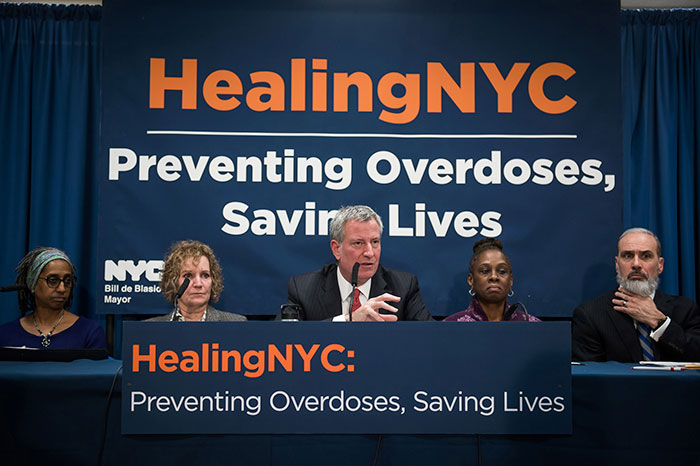Photo Courtesy of Ed Reed/Mayoral Photography Office
With this new investment, Mayor de Blasio noted, the City will spend a total of $60 million annually to reduce opioid overdose deaths.
By Michael V. Cusenza
The City is set to invest $22 million annually to expand its plan to reduce opioid overdose deaths in the five boroughs, Mayor Bill de Blasio and First Lady Chirlane McCray announced on Monday.
According to the administration, the new funds secured for HealingNYC will create peer-intervention programs at more hospitals across the city, increase naloxone distribution and training on how to use the lifesaving drug, and connect more New Yorkers struggling with substance misuse to treatment.
With this new investment, de Blasio noted, the City will spend a total of $60 million annually to reduce opioid overdose deaths.
According to the administration, in 2016, more than 1,000 people across the five boroughs died in a drug overdose which involved an opioid, the highest year on record. More New Yorkers died from opioid overdoses in 2016 than from car accidents and homicides combined, City officials said.
So the de Blasio administration started HealingNYC exactly a year ago with $38 million annually to implement the four initial strategies to help reduce opioid overdose deaths by 35 percent over the next five years: prevent opioid overdose deaths; prevent opioid misuse and addiction; connect New Yorkers to effective treatment; and reduce the supply of dangerous opioids.
According to the City Department of Health and Mental Hygiene, while the 2017 opioid overdose data is still provisional, the agency is seeing a flattening in the overdose death rate compared to 2016. The City predicts that this expanded HealingNYC could help save as many as 400 lives by 2022.
With the additional $22 million annual investment, the City said it will implement the following six strategies:
Expand Emergency Department Peer-Based Interventions: New York City Health + Hospitals will expand its peer advocate program from three to all 11 of its emergency departments by the end of 2018. DOHMH will complete expansion of the Relay peer intervention program to 15 private hospitals by June 2020, up from the 10 sites currently slated for funding.
Expand Inpatient Hospital Interventions at Health + Hospitals: NYC Health + Hospitals will expand plans for its Consult for Addiction Treatment and Care in Hospitals program from four to six sites, with four to be launched in fall 2018 and the other two by the end of 2019. CATCH teams will connect inpatients admitted with substance abuse disorder to medically assisted treatment and outpatient care. The six sites will be NYC Health + Hospitals/Bellevue, /Lincoln, /Metropolitan, /Coney Island, /Elmhurst, and /Woodhull.
Launch “Leave Behind” Naloxone Program: FDNY EMS will distribute 5,000 naloxone kits annually at homes they visit in response to an overdose call.
Establish End Overdose Training Institute: DOHMH will launch the End Overdose Training Institute by spring 2018 to teach 25,000 New Yorkers annually, how to administer and distribute naloxone.
Expand HOPE Program: The City will expand the HOPE program which diverts people arrested on low-level drug offenses into treatment rather than the criminal justice system. This new investment, according to the City, will divert an estimated 1,400 people annually from the system and connect them to medication-assisted treatment and other resources.
Expand Crisis Response Services: The City will hire 29 additional staff to expand the capacity of the Health and Engagement Assessment Team, and Rapid Assessment Response Team which help to respond to overdose calls.

